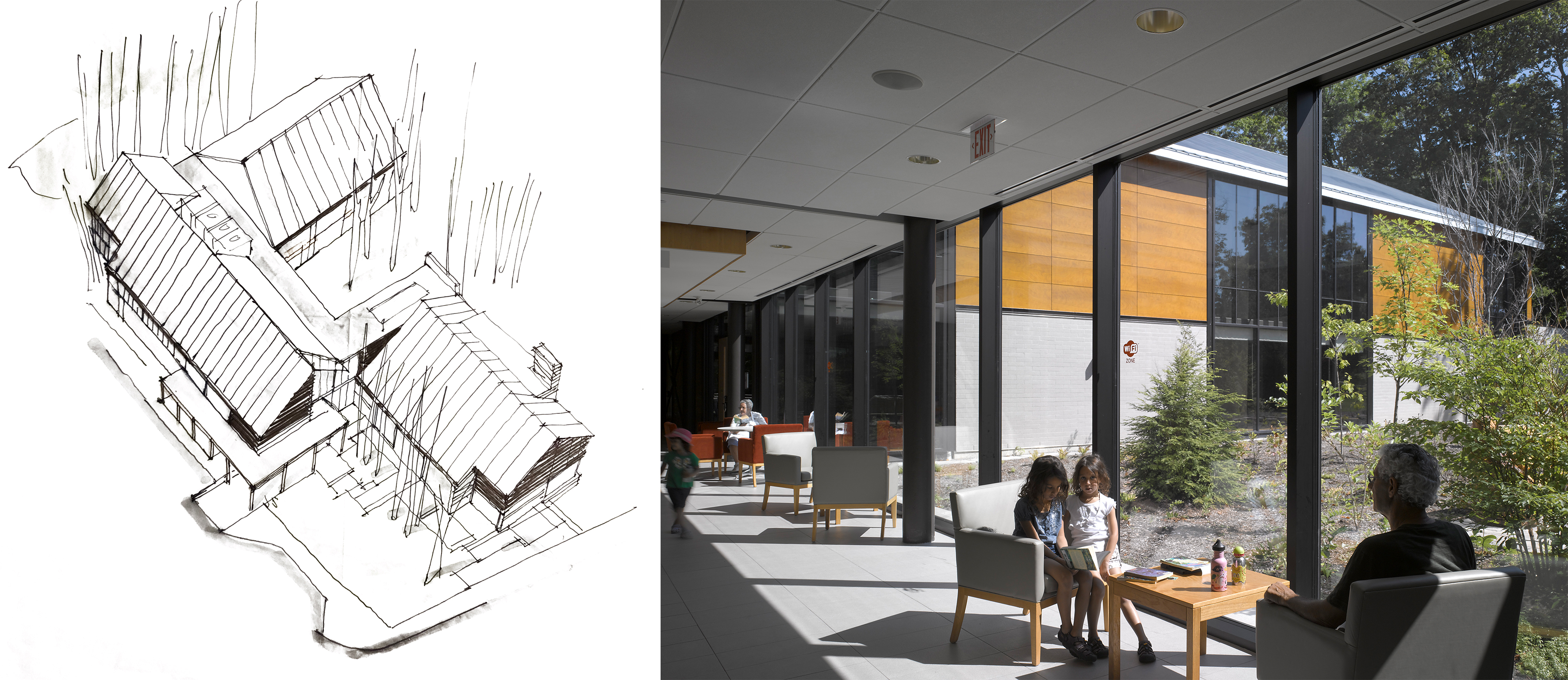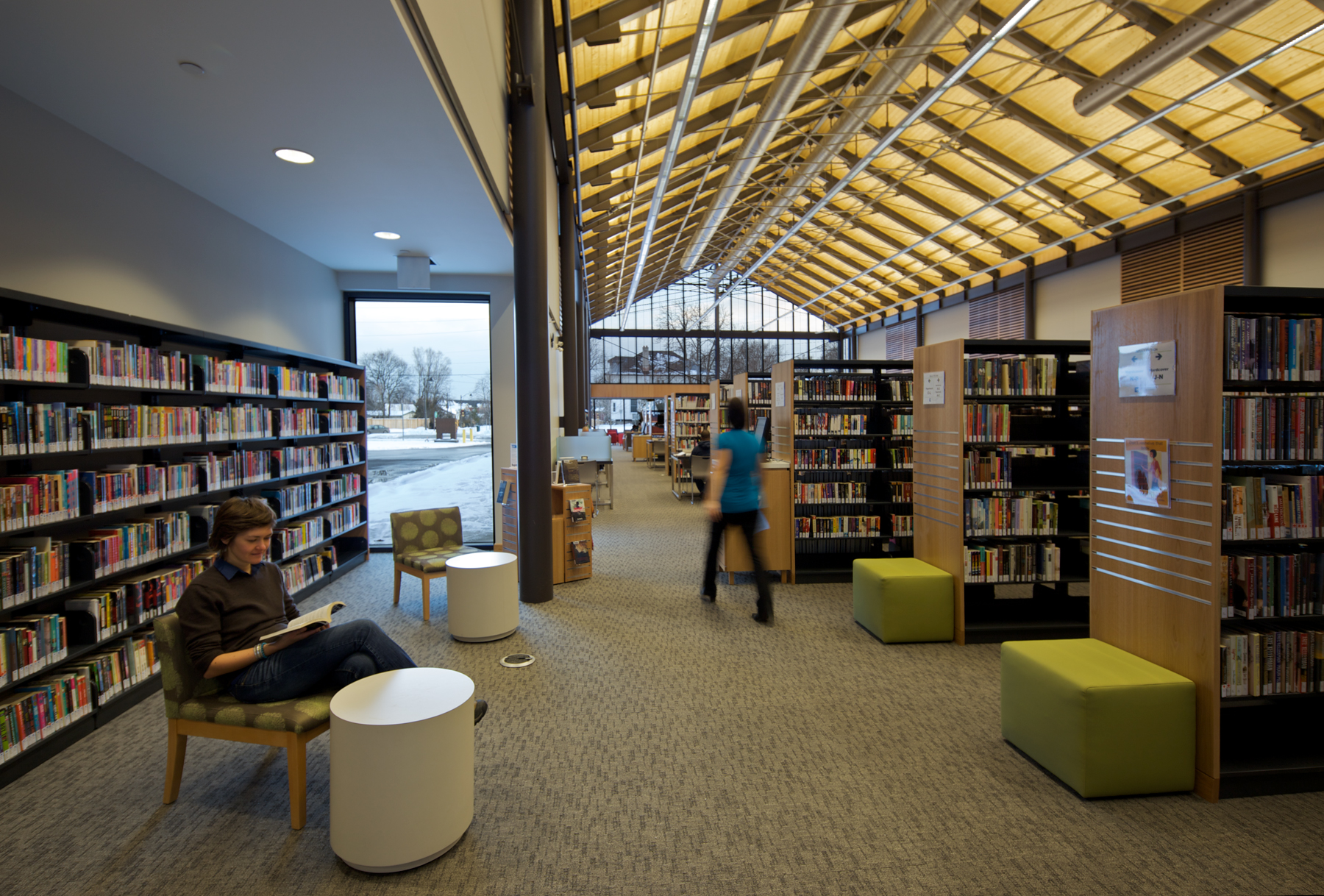Location: Whitby, Ontario
Date of Completion: 2010
Architect: Perkins+Will Canada Inc.
Nominated by: Lorne Coe, MPP (Whitby)
When tasked with designing a new community centre and library for Brooklin, a historic neighbourhood in the Town of Whitby, architects Perkins+Will Canada didn’t have to look far for inspiration. By respecting the immediate environment and drawing on local inspiration, the popular facility provides residents with a quality community space that is both sustainable, functional, and informed by context.
 Left: Architect’s sketch of configuration of buildings on the site. Right: Views between different wings of the complex. Images courtesy of Perkins+Will Canada Inc.
Left: Architect’s sketch of configuration of buildings on the site. Right: Views between different wings of the complex. Images courtesy of Perkins+Will Canada Inc.
The Past Inspiring the Future
The Brooklin Community Centre and Library is located near the centre of Brooklin, a historic town first settled in the early 19th century and now a part of Whitby in Durham Region. Surrounded by farms, the agrarian village recalls the familiar architecture of many small Ontario communities.
The two-storey, 41,000-square-foot facility features simple gable roofs and stone walls that harken back to the nearby Brooklin Flour Mill (1848) and Brooklin Township Hall (1876)—both inspirations for the architects’ design. Organized into distinct buildings that resemble three linked barns, the centre avoids an overly large massing and instead feels at home in a neighbourhood largely composed of small buildings. These gabled-shapes were the product of community feedback—an important part of designing public buildings.
 Left: Brooklin Flour Mill. Right: Brooklin Township Hall. Images courtesy of Perkins+Will Canada Inc.
Left: Brooklin Flour Mill. Right: Brooklin Township Hall. Images courtesy of Perkins+Will Canada Inc.
While the silhouette and scale of the project are inspired by the past, the lightness and airiness of the structure are decidedly modern. Southern façades constructed almost entirely of glass flood the interior with natural light, while also producing the effect of opening the building to the outdoors. Elsewhere, strategically placed windows frame views of the neighbouring park and forest, further enhancing the exterior connection. These large spans of glass are no trivial feat, and presented a challenge for the building’s structural engineers who designed sophisticated three-dimensional cable scissor trusses to support the roof.
 Interiors showing large windows and use of wood and steel. Images courtesy of Perkins+Will Canada Inc.
Interiors showing large windows and use of wood and steel. Images courtesy of Perkins+Will Canada Inc.
Heritage and Sustainability
Directly adjacent to the site stands another form of heritage: a remnant stand of hardwood forest. By breaking up the Centre into multiple structures—one housing the library, one housing the gymnasium, and another housing community spaces—the architects were able to organize the buildings on the site in a way that avoided removing mature trees and reduced impact on the existing site topography. This strategy helps redirect rainwater toward the forest, reducing unwanted runoff that could otherwise adversely affect the nearby Lynde Creek watershed. In the parking lot, rainwater is directed to filtering bioswales while roof runoff is collected for use as greywater.
Extensive use of wood, a traditional and readily available building material, helps further reduce the building’s environmental footprint. By including wood in both the structure and in finishes, carbon dioxide that was removed from the atmosphere during the growth of the tree is stored and sequestered. Structural steel, of which a significant proportion is recycled content, gives the building strength where it needs it most.
The opening of the Brooklin Community Centre and Library sparked a 150% increase in library circulation; the gymnasium and multi-purpose hall have become a popular hub and a revenue stream for the municipality. These results showcase the success of the Centre and the importance of creating public amenities that reflect their local surroundings and strive toward a more sustainable and community-oriented future.

Interior of library. Image courtesy of Perkins+Will Canada Inc.
This post forms part of our World Architecture Day Queen’s Park Picks 2023 series in which the OAA asked Ontario’s Members of Provincial
Parliament (MPPs) to nominate a prominent building, past or present, in
their riding for a chance to learn more about it. Check out the rest of
the series to learn more about great buildings across the province!